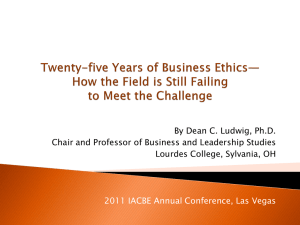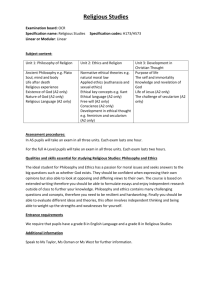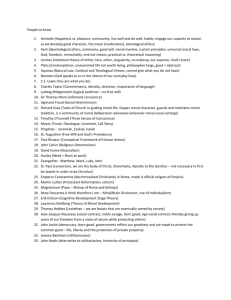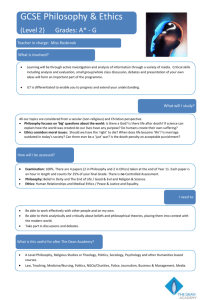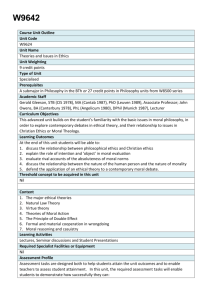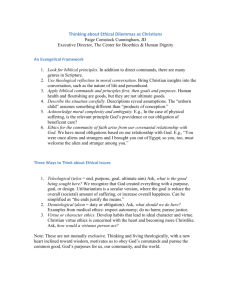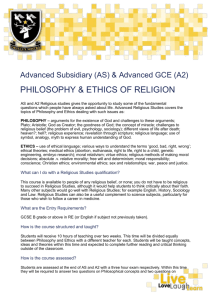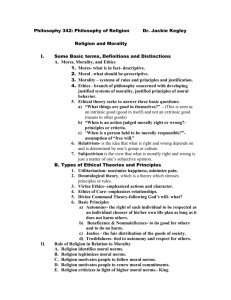Research topic: Can integrity be defined as a system with
advertisement
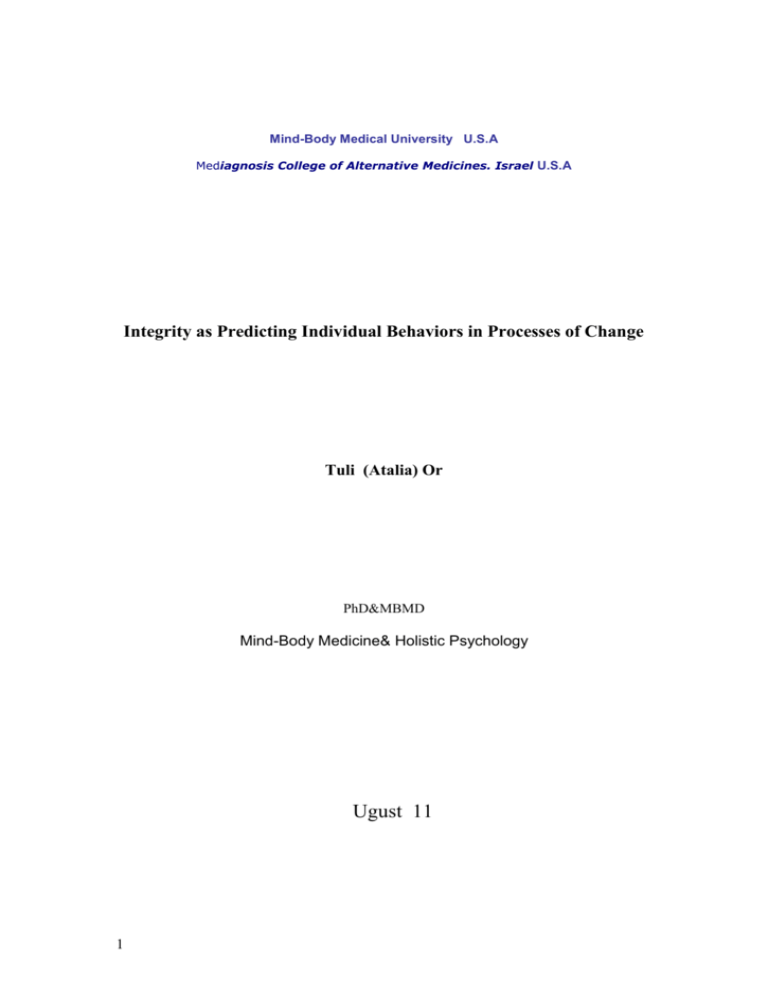
Mind-Body Medical University U.S.A Mediagnosis College of Alternative Medicines. Israel U.S.A Integrity as Predicting Individual Behaviors in Processes of Change Tuli (Atalia) Or PhD&MBMD Mind-Body Medicine& Holistic Psychology Ugust 11 1 Research topic: Integrity as Predicting Individual Behaviors in Processes of Change This study will include five chapters: 1. Purpose 2. Research Question 3. The research methodology. 4. The research findings. 5. Summary, conclusion, research contribution, research limitations. 1. Purpose The concept of integrity is perceived in the organization as an extremely abstract concept but everyone is able to identify its absence or existence. The impact of the managers' integrity on employee motivation is manifested in the feelings of trust, respect and appreciation towards him. It is difficult to define what integrity in an organization is. There are many studies on developing integrity amongst managers, but this researcher has not found work on identifying and mapping integrity in an individual, organization or a practical model enabling examination and identification of the phenomenon and its impact on the individual or organization. The study presents a holistic model that describes integrity as able to predict individual behaviors in an organization and in systems to which the individual is linked in diverse relationships entailing influence. The model facilitates predicting the individual's perception and behaviors, as well as the impact of these behaviors on the organizational culture, and the impact of this culture on the organizational results. The research will present an integrative a holistic model that explains the phenomenon of integrity and its ramifications for the organization including levels of execution and results that affect the organizational activity, such as decision-making, application, and achievements. 2 The model is intended to define integrity from an organizational perspective, as a complete, closed but dynamic system that can be divided into secondary systems, each of which can be defined as a complete formation in which integrity might exist. Similarly, it will explore the links between the closed system and secondary systems, and among secondary systems. The model is intended to make it possible to map and predict the organizational behavior and the derived results. By results, it is meant that the model is intended to enable clear identification of the relevant and missing secondary system for developing organizational growth. The model further is intended to enable bidimensional examination as follows: 1. Examination of individual integrity as a developmental sequence 2. Examination of individual integrity as a complex network (web structure) The brief description of the model (Appendix chart 1) presented below is based on the organizational perspective of the researcher, with one dimension pertaining to individual integrity as a developmental sequence with seven stages that define it as growing and expanding dynamically, on the basis of transformative processes that motivate it to change, in order to maintain the balance needed for its survival. These include: 1. Integrity focused on the individual as the "primary organization" 2. Integrity that combines consideration of immediate family 3. Integrity that combines consideration of immediate family and the community to which he belongs 4. Integrity that combines consideration of the individual's family, the community and the organization in which or with which he works 5. Integrity that combines consideration of the individual's family, the community and the organization in which or with which he works and to the nation/ state 6. Integrity that combines consideration of the individual's family, the community and the organization in which or with which he works, the nation and other countries 3 7. Integrity that combines consideration of the individual's family, the community and the organization in which or with which he works, the nation, other countries and the universe The second dimension envisioned by this researcher pertains to personal and organizational integrity as a complex network (Appendix chart 2) (web structure) lacking hierarchy, in which personal integrity can exist on the basis of interest (concern and conscious or unconscious need) without a hierarchy, while surviving as a modular structure, examples of which are: 1. Integrity focused on myself as the manager. 2. Integrity focused on myself as the manager and in the organization (the stage of family is lacking) 3. Integrity focused on myself as the manager and in the community (the stage of family is lacking) 4. Integrity focused on myself as the manager in the nation (the stage of the organization, or the community or the family is lacking or all of them are lacking) 5. Integrity focused on myself as the manager and on the universe (all the other factors are lacking) Key Terms: Integrity, change, individual and organization, development, management 2. The Literature Review The model will be studied using theoretical literature that will strengthen the assumptions regarding the proposed model, while presenting case studies and possibly field interviews. Relevance and originality of topic to improvement in key management area: The entire concept developed on the background of my many years of professional experience and observation of organizational processes based on human relationships and behaviors (individuals and groups). This experience led to questions connected to 4 integrity and affected commitment, credibility, responsibility and accountability – essential behaviors for the existence of a healthy organization. Insights were generated by the apparent absence of a model available to help consultants and managers to understand the subject of integrity at the most practical level, while offering a solution to the many dilemmas existing in our chaotic world. 3. Research Questions The main research question: Can integrity be defined as a system with components that can be dissembled? Secondary questions: 1. Does personal integrity develop or is it fixed? 2. Is integrity an open or a closed system? 3. Does integrity develop in consistent stages? 4. Is integrity the product of education or a natural development? 5. Can the organizational /or personal culture be identified and mapped using the integrity model? 6. Can managerial integrity and its impact on the organizational culture be identified? Management Context: The study will concentrate on the context of managers and their influence on changing the organizational culture (focusing on the personal and the organizational context). The management context will be the three branches of the Israel National Institute of Insurance. The study will include the various managerial levels of the office, where I will study the integrity of the managers. The branches have two chief managers (female and male), 16 senior managers, 30 mid-level managers and 170 employees. The branches are two of the 23 local branches scattered around Israel, and report to the headquarters, where all functions that exist in each branch are represented. The headquarter responsibilities are the general policy, including the service policy, the 5 personnel policy, and reward policy (e.g. monthly bonuses, based on personal performance), and monthly publishing of the performance measures of each of the organization departments and branches. The study will focus on the influence of the chief manager's integrity on the senior managers, and their integrity on the mid-managers. We will explore the dynamic relationships between the changes that each of the managers was exposed to, and their influences on the integrity in the individual, group and branch levels. We will also study the influence of the integrity levels on the branch performance results, and the influence of those results on the organization as a whole, in the context of the point of time in the organizational life cycle and an organizational culture. Integrity: The Oxford English dictionary (Oxford University Press 1995, 2002) defines integrity as: 1. The quality of having strong moral principles 2. The state of being whole 3. The condition of being unified or sound in construction The accepted organizational aspect(s) for the National Institute of Insurance, against which the integrity of the organization could possibly be measured, may perhaps then be generalized or modified as a model to apply to other industries. 4. The Research Method The thesis falls into the category of grounded theory research. It aims to present an integrative model that offers answers to questions and dilemmas to which there are no satisfactory answers, or explanations in the existing theories that focus on organizations. In grounded theory, the data emerges from the research to build the theoretical model for managing change. 6 4.1 Research Activities (validation) The validation of the emergent management model will be through questionnaires, interviews and examination of the literature review on studies on the subject of integrity and of theories from diverse disciplines, beginning in the fields of philosophy, psychology, sociology, management sciences, anthropology and ecology. The research conclusions will focus on presenting the model as facilitating and predicting individual/managerial behaviors in the organization, and the impact of these behaviors on organizational motivation. It will also afford a means of diagnosing and developing diverse awareness of the level of integrity and directions of change that can be generated amongst managers in the organization. The model can also provide a coaching tool that trains managers for efficient and integrative functioning in the organization and in general. 5. The Research Contribution This study focuses on developing a different approach to the concept of integrity as it appears in the professional literature. The professional literature makes many references to the need for integrity and for developing awareness among managers of the importance of this attribute in the organization. A significant part of it focuses on 'Where we want to be', expressed in the organization's vision, describing its ethics and extent. There is not much work on obstruction and its sources that prevent the organization and managers from developing integrity. Integrity is perceived as an abstract concept. The different direction of this work can make an important contribution to those who work as consultants in organizational development as well as to those who work as consultants to managers and managements. 5.1 The research limitations stem from the study describing integrity as a dynamic process based on a theoretical model for which all the tools have not yet been developed which can validate it in diverse organizations and cultures. Similarly, the model is based on the researcher's personal perception 7 and experience using qualitative research, and has not been tested in foreign organizations. An array of tools can be developed in the future that will enable validating the model and intensifying the research into issues that arise during the work, such as whether integrity is based on a spiral growth axis, or, for example, as a network based on one or several axes. Similarly, the predictive ability of regressive facets on the axis can be explored. These topics have not yet been studied but can provide a basis for further research. References Adizes I.(1992) Mastering Change New York: Prentice Hall. Adizes, I. (1999). Managing corporate lifecycles. New York: Prentice Hall. Alcoff, L.M. (2002). Does the public intellectual have intellectual integrity?’ Metaphilosophy 33, 521-534. Erikson E.H. Childhood and society. (1950) Adapted and translated by permission. Arie de Geus: The Living Company (1997) by Longview Publishing Limited . .Erikson E.H. (1975) Identity crisis in autobiographic perspective. In E. H/ Erikson, Life history in the historical moment N. Y. Norton Ashford, E. (2000). Utilitarianism, integrity and partiality. Journal of Philosophy 97, 421-439. Babbitt, S. E. (1997). Personal integrity, politics and moral imagination. In: S. Brennan, T. Isaacs, & M. Milde, (Eds.). A question of values: New Canadian perspectives on ethics and political philosophy. Amsterdam and Atlanta: Rodopi. Bankart, C.P. (1997). Talking cures, a history of Eastern psychotherapies. New York: Brooks/Cole Publishing Company Baron, M. (1995). Kantian ethics almost without apology. Ithaca: Cornell University Press. Beak, D.E. & Cowan C. C. (1999). Spiral dynamics mastering values leadership, and change. London: Blackwell. Beauvois, J.L. & Jouel, R.V. (1996). A radical dissonance theory. Taylor & Francis Ltd. Becker, T. E. (1998). Integrity in organizations: Beyond honesty and consciousness. Academy of Management Review, 23(1): 154-161. Benjamin, M. (1990). Splitting the difference: Compromise and integrity in ethics and politics. Lawrence: University Press of Kansas. Blustein, J. (1991). Care and commitment: Taking the personal point of view. New York: Oxford University Press. 8 Bohm, D. (1997). Thought as a system. London: Rutledge. Bowie, L. K. Higgins & M. Michaels (Eds.), (1999). Standing for something. Excerpt reprinted in Thirteen Questions in Ethics. New York: Harcourt Brace. Brides, W. (1999). Managing transitions making the most of change. Calhoun, C. (1995). Standing for something. Journal of Philosophy XCII. Carr, S. (1976). The integrity of a utilitarian. Ethics 86, 241-46. Cortright, B. (1997). Psychotherapy and spirit. State University of New York Press Cox, D., La Caze, M., & Levine, M. P. (1999). Should we strive for integrity? Journal of Value Inquiry Vol. 33, No. 4. Cox, D., La Caze, M., & Levine, M. P. (2003). Integrity and the fragile self. London: Ashgate. Damasio, A. R. (1999). The feeling of what happens, body and emotion of consciouness. Harcourt Brace & Company Davion, V. (1991). Integrity and radical change. Feminist ethics. C. Card (Ed.). Lawrence, Kansas: University of Kansas Press. Don Edward BEACK, Christopher C. Cowan(2000) Spiral Dynamics, Mastering values, Leadership, and Change: Blackwell Publishers Inc. Goleman D. (1998) Workin with emotional intelligence Epstein, M. (1995). Thoughts without a thinker. Psychotherapy from a Buddhist perspective. Basic Books. Fagan, A.J., & Shepherd, I.L. (1970). Paradoxical theory of change. In: A.J. Fagan & I.L. Shepherd, Gestalt therapy now. Palo Alto, CA.: Science and Behavior Books. Festinger, L. (1985). A theory of cognitive dissonance. Stanford University Press Frankel, V. (1970). Man's search for meaning. An introduction to logotherapy. Tel Aviv: Dvir. (Hebrew) Frankfurt, H. (1971). Freedom of the will and the concept of a person. Journal of Philosophy LXVIII, 5-20. Frankfurt, H. (1987). Identification and wholeheartedness. F. Schoeman, (Ed.) Responsibility, character, and the emotions: New essays in moral psychology. New York: Cambridge University Press. Gilligan, C, (1982). In a different voice. Cambridge, Mass: Harvard University Press. Godlovitch, S. (1993). The integrity of musical performance. Journal of Aesthetics and Art Criticism. 51(4): 573-587. Graham, J. L. (2001). Does integrity require moral goodness? Ratio 14, 234251. Grant, R. W. (1997). Hypocrisy and integrity. Chicago and London: University of Chicago Press. Haack, S. (1976). Concern for truth: What it means, why it matters. Annals – NY-Academy of Science, 775: 57-63. Halfon, M. (1989). Integrity: A philosophical inquiry. Philadelphia: Temple University Press. Harcourt, E. (1998). Integrity, practical deliberation and utilitarianism. Philosophical Quarterly 48, 189-198. 9 Harmon-Jones, E. & Mills, J. (1999). Cognitive dissonance progress on a pivotal theory in social psychology. American Psychological Association, Washington. DC Harris, G. W. (1989a). Integrity and agent centered restrictions. Nous, 23, 437456. Harris, G. W. (1989b). A paradoxical departure from Consequentialism. Journal of Philosophy 86, pp. 90-102. Herbert, M. R. (2002). Integrity, identity and fanaticism. Contemporary Philosophy 24, 25-29. Herman, B. (1983). Integrity and impartiality. Monist 66, pp. 233-250. Holley, D. M. (2002). Self-interest and integrity. International Philosophical Quarterly 42, 5-22. Jensen, H. (1989). Kant and moral integrity. Philosophical Studies 57, 193-205. Joseph Luft (1963) - Group processes - An introduction to group dynamics: Kahneman, D. and authors, (2005). Rationality, fairness, happiness. Selected Writings. M. Bar-Ilan (Ed.) (Hebrew) Kasulis, T. P. (2002). Intimacy or integrity. Philosophy and culture difference,,,, University of Hawaii Press. Kegan, R. (2000). In over our heads. The mental demands of modern life. Harvard: Harvard University Press. Kegan, R., & Laskow, L. (2000). The way we talk can change the way we work. San Francisco: Jossey Bass. Kekes, J.. (1983). Constancy and purity. Mind 92, 499-518. Kotter, J.P. (1996), Leading change. Boston: Harvard University Press. Kurt Levin (1989) Resolving Social Conflicts Lawry, E. G. (2002). In praise of moral saints. Southwest Philosophy Review 18, 1-11. Lazarus, R. S., & Lazarus, B. N. (1994). Passion and reason: Making sense out of emotion. Oxford: Oxford University Press. Lenman, J. (2000). Consequentialism and cluelessness. Philosophy and Public Affairs 29, 342-370. Lomasky, L. (1987). Persons, rights, and the moral community. Oxford: Oxford University Press. Mahony, M.J. (1991). Human change processes. The scientific foundations of psychotherapy. Basic Books McFall, L. (1987). Integrity. Ethics 98, 5-20. Reprinted in John Deigh (ed.), Ethics and Personality, Chicago: University of Chicago Press, 1992, 7994. McFall, L. (1999). Responsibilities of scientists and intellectuals. Routledge Encyclopaedia of Philosophy. 287-90. Meriam-Webster's Collegiate Dictionary. 10th edition, 2002. Montefiore, A. (1978). Self-reality, self-respect, and respect for others. Midwest Studies in Philosophy 3, 195-208. Murphy, P. A. (2002). Integrity as a moral imperative: Some difficulties at the borders of moral integrity. Contemporary Philosophy 24, 9-11. Nevis, E. C., Lancourt, J., & Vassallo, H.G. (1996). Intentional revolutions: A seven-point strategy for transforming organizations. San Francisco: Jossey Bass. Novitz, D. (1990). The integrity of aesthetics. Journal of Aesthetics and Art 10 Paul Watzlawik, Johon H. Weakland, Richard Fich (1979) Change Principles of Problem Formation and Problem Resolution. Criticism, 48(1): 9-20. Petrick, J. (2001). Leadership, judgment, integrity, capacity, and sustained information technology innovation. Journal of Management Systems. Petrick, J. A. & Quinn, J. (2001). The challenge of leadership accountability for integrity capacity as a strategic asset. Journal of Business Ethics, 24, 1-13. Petrick, J. A. & Quinn, John F. (2000). The integrity capacity construct and moral progress in business. Journal of Business Ethics, 23, 3-18. Petrick, J. A. (1999). Business leadership judgment integrity and sustainable competitive advantage in the global digital economy. Global Business & Economics Review, 1 (1), 17-30. Petrick, J. A., & Quinn, J. (2004). Restoring integrity capacity to domestic and international accounting. Global Business and Economics Review, 6 (1), 121. Petrick, J., & Quinn, J. (2002). Integrity, capacity, business, citizenship and Enron stakeholder remedies. Global Business and Economics Review, 4 (2), 205222. Petrick, J.A., & Quinn, J. (2001). The challenge of leadership accountability for integrity capacity as a strategic asset. Journal of Business Ethics. Peter Gay (1988) Freud - A Life For Our Time. Polstar, E., & Polstar, M. (1973). Gestalt therapy integrated: Contours of theory and practice. Vintage Books. Putman, D.l (1996). Integrity and moral development. The Journal of Value Inquiry 30, pp. 237-246. Quinn, R. E. (1996). Deep change: Discovering the leader within. San Francisco: Jossey Bass. Railton, P. (1984). Alienation, consequentialism and the demands of morality. Philosophy and Public Affairs 13, 134-72. Ridge, M. (2001). Agent-neutral consequentialism from the inside-out: Concern for integrity without self-indulgence. Utilitas 13, 236-254. Rogerson, K. (1983). Williams and Kant on integrity. Dialogue 22, 461-478. Scheffler, S. (1993). The rejection of consequentialism, Revised Edition, Oxford: Oxford University Press. Schmink, M. (1998). Managerial ethics: Moral management of people and processes. Lawrence Erlbaum. Scotten, B.W., Chinen, A.B., & Battista, J. R. (1996). Textbook of transpersonal psychiatry and psychology. New York: Basic Books. Senge, D. (1990), The fifth discipline. The art and practice of learning organization. N.Y.: Currency Doubleday. Senge, P. Otto, C., Scharmert, J., Jaworski, B., & Flowers, S. (2004). Presence, human purpose and the field of future. The Society for Organizational Learning. Shaw, R. B. (1997). Trust in the balance: Building successful organizations on results, integrity, and concern. San Francisco: Jossey Bass. Smart, J.J.C. (1998). An outline of system of utilitarian ethics. Cambridge: Cambridge University Press. 11 Smart, J.J.C., & Williams, B. Utilitarianism: For and against. New York: Cambridge. Smiith, E. (1997). Integrity and change mental health in the marketplace. Eleen Smith Srivastva, S. (1989). Executive integrity – The search for high human values in organizational life. San Francisco: Jossey Bass. Sutherland, S. (1996). Integrity and self-identity. Philosophy, Supplementary Volume 35, 19-27. Tarnas, R. (1993). The passion of the western mind. New York: Ballantyne Books. Taylor, G. (1981). Integrity. Proceedings of the Aristotelian Society, Supplementary Volume 55, 143-159. Taylor, G. (1985). Integrity. Pride, shame and guilt: Emotions of selfassessment. Oxford: Oxford University Press. Tchernichovsky, S. (1911). Poems. Tel Aviv: Shelach. (Hebrew) Trianosky, G. W. (1986). Moral integrity and moral psychology: A refutation of two accounts of the conflict between utilitarianism and integrity. Journal of Value Inquiry 20, 279-288. Van Hooft, S. (2001). Judgment, decision, and integrity. Philosophical Explorations 4, 135-149. Victor E. frankel (1985) The Will to Meaning :by Dvir Co. Watzlawick, P., Weakland, J., & Fisch, R. (1974). Change: Principles of problem formation and problem resolution. New York: Norton & Co. Williams, B. (1973). Integrity. Williams, B. (1981a). Utilitarianism and moral self-indulgence. Moral Luck: Philosophical Papers 1973-1980. Cambridge: Cambridge University Press. Williams, B. (1981b). ‘Persons, Character and Morality.’ Moral Luck, 1-19. Williams, B. (1981c). Moral luck. Moral Luck, William Bridges (1999) : Managing Transitions Making The Most of Change: Published by arrangement with Addison - Wesley Publishing Company. Zagzebski, L. (1996). Virtues of the mind: An inquiry into the nature of virtue and the ethical foundations of knowledge. Cambridge: Cambridge University Press. 12 Appendix: Integrity - Developing structure (chart 1) Integrity - Web Structure (chart 13 2) Map of a multi-stage system of integrity Integrity stage Stage Function Physical integration Physical and mental integration Family/couples Focus on survival 3 Community (faith/religion) Focus on system that meets emotional, mental, spiritual needs and social security 4 Organization Focus on system that meets economic, social and achievementoriented needs 5 State/nation 6 World/ universality Focus on the system that meets emotional, mental, social, economic needs and national security Focus on a system that meets 1 2 14 Survival; focus on self Focus on system that meets emotional, existential, social needs Values Relevance and responsibility Responsibility, concern and commitment to self Responsibility, concern and commitment to self and descendents, trust and respect of descendents Responsibility, concern and commitment, trust and respect for the other, values of religion/community Responsibility, concern and commitment, trust and respect for members of the organization, organizational values Responsibility, concern and commitment, trust and respect for others, civil values On the basis of basic survival needs On the basis of blood relations Responsibility, concern and On the basis of a common On the basis of a common social interest On an economic basis On the basis of a common belief for a shared nation 7 15 Universe economic, security, ecological needs (globalized ecology, economy, culture, society) Focus on a system that meets spiritual needs commitment, trust and respect of differences, national values, religions defined interest Responsibility, concern and commitment, trust and respect of differences, values, languages On a human basis

